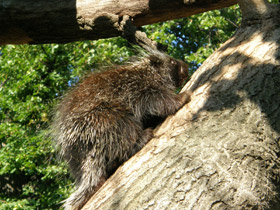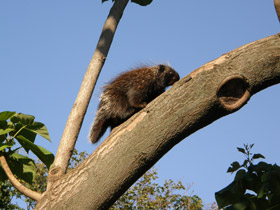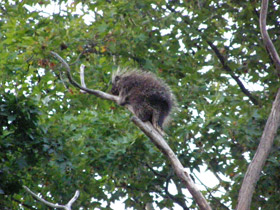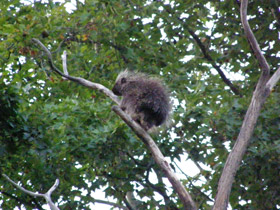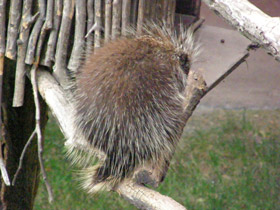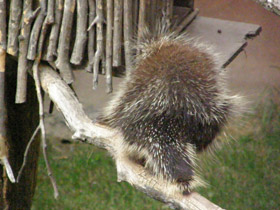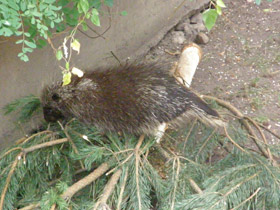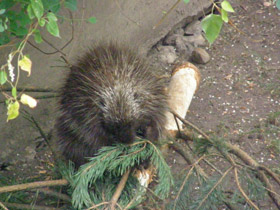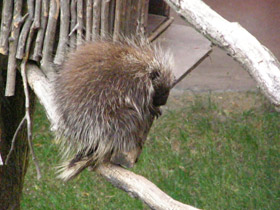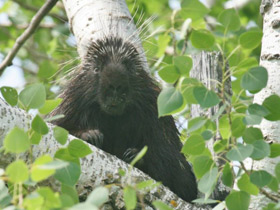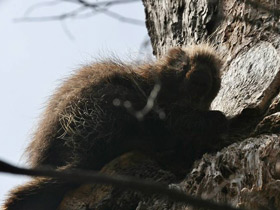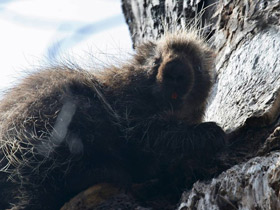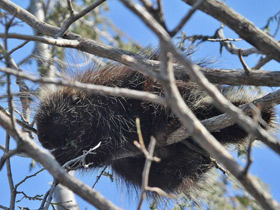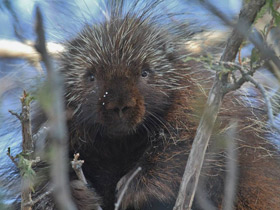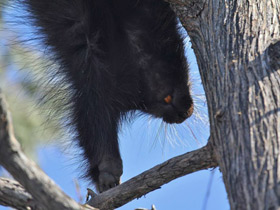The North American porcupine (Erethizon dorsatum), Canadian porcupine
The North American porcupine (Erethizon dorsatum), also known as the Canadian porcupine, is a large quill-covered rodent in the New World porcupine family. It is the second largest rodent in North America after the North American beaver (Castor canadensis). The porcupine is a caviomorph rodent whose ancestors crossed the Atlantic from Africa to Brazil 30 million years ago, and then migrated to North America during the Great American Interchange after the Isthmus of Panama rose 3 million years ago.
One hears the phrase "wild image" in the word "porcupine", which very accurately characterises the appearance of these unusual rodents. "Wild" and terrible they are made by numerous long and sharp barbs that cover the back, sides and tail of animals. True, they are not intended for attack - it is just a means of defence against predators. Erethizon dorsatum are slow, awkward and, unlike most rodents, not distinguished by intelligence, so the needles are their only defence against predators. To scare away an enemy, Erethizon turns backwards and raises its needles. If the threat does not work, the porcupine rushes towards the offender, and its needles pierce into the body of the predator. Later, the needles swell with the blood of the animal whose body they have pierced, and cause him great discomfort. It is very difficult to remove them, and sometimes the predator can even die without being able to hunt, eat or rest.
There are two families of porcupines: Porcupineidae - live in southern Eurasia and Africa and lead a terrestrial lifestyle. Erethizon dorsatum - found only in South and North America and are excellent tree climbers.
Etymology
The word "porcupine" comes from the middle or old French word porcespin, which means 'thorn pig'. Its roots derive from the Latin words porcus or pig and spina meaning thorns. Other colloquial names for the animal include quill pig. It is also referred to as the Canadian porcupine or common porcupine. The porcupine's scientific name, Erethizon dorsatum, can be loosely translated as "the animal with the irritating back". Native American terms for it include the Lakota name pahin meaning quill, the Ho-Chunk name waxąhį, and the Chipewyan name ts'l.
Taxonomy and evolution
The North American porcupine migrated from South America, where all New World porcupines or hystricomorphs evolved. Erethizon appeared in North America shortly after the two continents joined together in the later Tertiary period. Other hystricomorphs also migrated, but Erethizon was the only one to survive north of Mexico. No known fossils are attributed to hystricomorphs prior to the late Tertiary period. Some fossils, such as species from the family Paramyidae, show resemblance to the porcupine, but they are so primitive and generalized that they could be ancestors to all later rodents.
South American hystricomorphs first appeared in the Lower Oligocene period. They are thought to have migrated from Africa, ancestors of the Old World porcupines or Hystricidae or they originated based on a migration of the North American Paramyidae.
The earliest appearance of E. dorsatum is from the Pleistocene era found along the Arroyo del Cedazo near Aguascalientes, Mexico.
Subspecies
Seven subspecies of Erethizon dorsatum are recognized. They are subdivided by different ranges across North America. By far the most common is Erethizon dorsatum dorsatum, which ranges from Nova Scotia to Alberta and from Virginia to the Yukon. Erethizon dorsatum picinum occupies a small range in northeastern Quebec and Labrador. Erethizon dorsatum couesi is the most southern ranging from northern Mexico to Colorado. Erethizon dorsatum bruneri can be found in the midwest from Arkansas to Montana. The last three are found in the west. From south to north they are Erethizon dorsatum epixanthum, Erethizon dorsatum nigrescens, and Erethizon dorsatum myops.
Description
Porcupines are usually dark brown or black in color, with white highlights. They have a stocky body, a small face, short legs, and a short, thick tail. This species is the largest of the New World porcupines and is the second largest North American rodent, after the American beaver. The head-and-body length is 60 to 90 cm (2.0 to 3.0 ft), not counting a tail of 14.5 to 30 cm (5.7 to 11.8 in). The hind foot length is 7.5 to 9.1 cm (3.0 to 3.6 in). Weight can range from 3.5 to 18 kg (7.7 to 39.7 lb). Weight in adult females can average some 7 kg (15 lb) while 5 wild-caught males averaged 10.67 kg (23.5 lb).
The porcupine possesses antibiotics in its skin which may help prevent infection when a porcupine falls out of a tree and is stuck with its own quills upon hitting the ground. Porcupines fall out of trees fairly often because they are highly tempted by the succulent buds and tender twigs at the ends of the branches. The porcupine, the wolverine, and the skunk are the only North American mammals that have strongly contrasting black-and-white coloration, because they are the only mammals that benefit from letting other animals know where and what they are in the dark of night.
Quills
The most distinguishing feature of the porcupine is its coat of quills. An adult porcupine has about 30,000 quills that cover all of its body except its underbelly, face, and feet. Quills are modified hairs formed into sharp, barbed, hollow spines. They are used primarily for defense, but also serve to insulate their bodies during winter. The quills are normally flattened against the body and in this position are less easily dislodged. Porcupines do not throw their quills, but when threatened contract superficial muscles which cause the quills to stand up and out from their bodies. In this position they become easier to detach from the body, especially when the tail is swung toward an attacker. The barbs at the end of the spines lodge in the flesh of a victim and are difficult and painful to remove.
Stench
The North American porcupine has a strong odor to warn away predators, which it can increase when agitated. The smell has been described as similar to strong human body odor, goats, or some cheeses. The odor is generated by a patch of skin called the rosette, on the lower back where modified quills serve as osmetrichia to broadcast the smell.The characteristic odor comes from the R-enantiomer of delta-decalactone. Not present is the S-enantiomer which smells like coconut and is used in flavorings and perfumes.
Distribution and habitat
In eastern North America, porcupines range from Canada to the Appalachian Mountains in West Virginia and Maryland. In the west they range from Alaska to northern mountains in Mexico. They are commonly found in coniferous and mixed forested areas, but have adapted to harsh environments such as shrublands and tundra. They make their dens in hollow trees or in rocky areas.
Diet
During the summer, they eat twigs, roots, stems, berries, leaves, and other vegetation. Porcupines also eat certain insects and nuts. In the winter, they mainly eat conifer needles and tree bark. Porcupines are selective in their consumption; for example out of every 1,000 trees in the Catskill Mountains, porcupines will only eat from 1-2 linden trees and one big-toothed aspen.
Behavior
Porcupines are nearsighted and slow-moving. They are mainly active at night (nocturnal); on summer days, they often rest in trees. They do not hibernate, but sleep in and stay close to their dens in winter. The strength of the porcupine's defense has given it the ability to live a solitary life, unlike many herbivores, which must move in flocks or herds. Consequently, the porcupine has "an extraordinary ability to learn complex mazes and to remember them as much as a hundred days afterward".
Reproduction
Female porcupines are solitary for most of the year except during the fall when breeding season begins. At this time, they secrete a thick mucus which mixes with their urine. The resulting odor attracts males in the vicinity. Males that approach a female do not automatically begin mating. The first male that comes along typically sits in the same tree below a female. If another male approaches, he may fight for the right to mate. Once a dominant male is successful, he approaches the female and uses a spray of his urine on the female. Only a few drops touch the female, but the chemical reaction allows the female to fully enter estrus. Once this is accomplished high in the tree, the mating process takes place on the ground. When porcupines are mating, they tighten their skin and hold their quills flat, so as not to injure each other. Mating may occur repeatedly until the female loses interest and climbs back into the tree.
The North American porcupine has a long gestation period relative to other rodents, an average of 202 days. By contrast, the North American beaver, which is comparable in size, has a gestation period of 128 days. The eastern grey squirrel (Sciurus carolinensis) has a gestation period of just 44 days. Porcupines give birth to a single young. At birth, they weigh about 450 g, which increases to nearly 1 kg after the first two weeks. They do not gain full adult weight until the end of the second summer about 4.5 kg. Their quills harden soon after birth.
Female porcupines provide all parental care. For the first two weeks the young rely on their mother for sustenance. After this they learn to climb trees and start to forage. They continue to nurse for up to four months, which coincides with the fall mating season. They stay close to their mothers. Mother porcupines do not defend their young, but have been known to care for them even after death. In one case, when a baby had fallen to its death from a tree, the mother came down and stayed by her offspring's side for hours waiting vainly for it to revive.
Life expectancy
North American porcupines have a relatively long life expectancy, with some individuals reaching 30 years of age. Common causes of mortality include predation, starvation, falling out of a tree, and being run over by motor vehicles.
Porcupines and humans
Porcupines are considered by some to be pests because of the damage that they often inflict on trees and wooden and leather objects. Plywood is especially vulnerable because of the salts added during manufacture. They also often injure domestic dogs who inspect or attack them.
Their quills are used by Native Americans to decorate articles such as baskets and clothing. Porcupines are edible and were an important source of food, especially in winter, to the native peoples of Canada's boreal forests. They move slowly (having few threats in their natural environment) and are often hit by vehicles while crossing roads.
Porcupines are infamous among backpackers and backpacking publications for their love of salt, especially eating road salt-covered boots left outside of tents overnight. They have a similar reputation among forestry workers of all types for trying to eat sweat-soaked gloves and wooden handles on tools.
Conservation status
Globally, the North American porcupine is listed as a species of least concern. It is common throughout its range except in some U.S. states in the southeast part of its range. For example, it is listed as a species in need of conservation in Maryland. As of 1999, 15 remnant populations remain scattered throughout north-central Mexico. These live in riparian forests, mesquite scrubland, grasslands, and thorn forests. They are threatened by hunting and habitat loss. As of 1994, the animal was listed as an endangered species in Mexico.
There are about 20 recognized species of terrestrial porcupines, while 23 porcupine species are rather arboreal; the latter are called American porcupines. All arboreal porcupines live in Western hemisphere and only one species, the North American porcupine, occurs in North America. This animal has dense fur with dorsal guard hairs and sharp quills extending from head to tail on the dorsal surface. Although the quills of this porcupine are not as long as the quills of some other porcupine species and their lengths do not exceed 11 cm, there may be as many as 30 thousands of quills. The porcupine quills detach easily when touched; they are the main mean of the porcupine defence. The North American porcupine does not attack any animal but when threatened, it lowers its head, turns its back, raises the quills and lashes out at the threat with its tail, trying to scare the enemy off. If the porcupine hits an animal with its quills, the quills become embedded in the animal. The quills do not slide off easily and if the predator is hit in a vital place, it may die of infection. Porcupine has one more interesting feature: its quills are coated with antibiotic fatty acids and the concentration of acids is higher in summer than in winter. The fatty acids help speed up the healing process in case the porcupine accidentally pierces its own skin when it falls down from a tall tree.
The North American porcupine is well adapted to arboreal life; due to its long, sharp claws it is able to confidently (though slow) climb trees. The North American porcupine occurs in the forests of North America, from Alaska to Mexico. Porcupines prefer pine and aspen forests but can live in a variety of habitats including tundra, grasslands, and desert shrub communities. Depending on the habitat, the porcupines can live in trees or in the dens; the animals living in the dens climb trees only for foraging. Amount of time spent on the ground depends on the density of both predators and ground food. The North American porcupine is solitary, although it may den with other porcupines in the winter, foraging in the group consisting of up to 20 animals. It is nocturnal animal which is active all year round. The North American porcupine eats all types of vegetation, including tree bark, acorns and nuts, young leaves, and grass. It especially likes apples. Porcupines can feed on the same tree (for instance, sugar maple) for several days. Porcupine diet varies significantly depending on the season. In autumn and winter, the porcupine strips outer layers of tree bark and eats juicy internal layers that contain starch and sugar; in spring, it feeds in trees, enjoying flowers and soft leaves. In summer time, the porcupine consumes various grasses, tubers, and fruit. During winter months, North American porcupines eat buds and tree bark, giving preference to the maple, poplar, and spruce. The North American porcupine has earned a bad reputation for killing timber and ornamental trees by stripping bark from the trunks. The North American porcupine is a large rodent: its body length ranges from 64 to 86 cm and its tail adds 30 cm to the total body-tail length. Despite its clumsy appearance, this animal is a good swimmer.
The mating system of the North American porcupine is considered female defense polygyny. A male mates with several females. In April-June, after gestation period of 210 days, the female gives birth to a single young. The baby is born well developed, with open eyes; it weighs between 400 and 500 grams and has a body length of about 60 cm. Soft quills dry up and harden in 30 minutes after birth. The porcupette is able to follow its mother in the first day of life, demonstrating typical defence reactions. The female suckles its baby quite often but the young starts eating some solid food within its first month of life. While nursing the young, the female sits on her thighs and tail. The female and her young meet only at night. During the day the baby is hidden on the ground, while the mother sleeps in the trees. The young becomes independent on its fifth month of life; young females reach sexual maturity by 26 months of age, the males, by 30 months.
Porcupines were once revered by Native American cultures throughout the continent as a food source, a source of quills for decoration, and legendary status. Today they are mostly considered as pests but there are no major threats to the species as a whole.

















